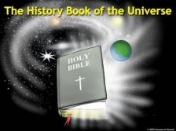 Christmas Symbolism
THE MIRACLE:
"Therefore the Lord Himself will give you a sign: The virgin will be with Child and will give birth to a Son, and will call Him Immanuel." (Isaiah 7:14)
THE BIRTH ANNOUNCEMENT: "But the angel said to them, 'Do not be afraid. I bring you good news of great joy that will be for all the people. Today in the town of David a Savior has been born to you; He is Christ the Lord. This will be a sign to you: You will find a baby wrapped in cloths and lying in a manger.' Suddenly a great company of the heavenly host appeared with the angel, praising God and saying, 'Glory to God in the highest, and on earth peace to men on whom His favor rests.'" (Luke 2:10-14) THE PERFECT GIFT: "Every good and perfect gift is from above . . ." (James 1:17a) THE GREATEST GIFT: " . . . the free gift of God is eternal life in Christ Jesus our Lord." (Romans 6:23b) THE PERMANENT GIFT: "For God so loved the world that He gave His one and only Son, that whoever believes in Him shall not perish but have eternal life." (John 3:16) THE TRUE LIGHT REPRESENTED WITH HOLIDAY LIGHTS: "Again therefore Jesus spoke to them, saying, 'I am the light of the world; he who follows Me shall not walk in the darkness, but shall have the light of life.'" (John 8:12) THE LORD IS PRAISED THROUGH MUSIC: "Praise the Lord. Praise God in His sanctuary; praise Him in His mighty heavens. Praise Him for His acts of power; praise Him for His surpassing greatness. Praise Him with the sounding of the trumpet, praise Him with the harp and lyre, praise Him with tambourine and dancing, praise Him with the strings and flute, praise Him with the clash of cymbals, praise Him with resounding cymbals. Let everything that has breath praise the Lord. Praise the Lord." (Psalm 150:1-6) THE FOOD: "Taste and see that the Lord is good; blessed is the man who takes refuge in Him." (Psalm 34:8) THE WREATH: "The soldiers twisted together a crown of thorns and put it on His head . . ." (John 19:2) THE COLOR RED SYMBOLIZES EVERLASTING LIFE: "In Him we have redemption through His blood, the forgiveness of sins . . ." (Ephesians 1:7a) THE DESIGN IN A CANDY CANE: ". . . by His stripes we are healed." (Isaiah 53:5b) THE DOVE: "and the Holy Spirit descended on Him in the bodily form like a dove. And a voice came from heaven; 'You are My Son, whom I love; with You I am well pleased.'" (Luke 3:22) THE NUTCRACKER SOLDIERS ARMOR: "Therefore put on the full armor of God, so that when the day of evil comes, you may be able to stand your ground, and after you have done everything, to stand. Stand firm then, with the belt of truth buckled around your waist, with the breastplate of righteousness in place, and with your feet fitted with the readiness that comes from the gospel of peace. In addition to all this, take up the shield of faith, with which you can extinguish all the flaming arrows of the evil one. Take the helmet of salvation and the sword of the Spirit, which is the word of God." (Ephesians 6:13-17) THE EVERGREEN TREE SYMBOLIZES EVERLASTING LIFE: "Jesus said to her, 'I am the resurrection and the life; he who believes in Me shall live even if he dies, and everyone who lives and believes in Me shall never die. Do you believe this?'" (John 11:25-26) THE TRADITIONS CHANGE, YET GOD'S WORD IS ETERNAL: "Heaven and earth will pass away, but My words will not pass away." (Mark 13:31) THE BEST GIFT TO SHARE: "for everyone who calls on the name of the Lord will be saved." (Romans10:13) =====================================================
SANTA CLAUS The origin of Santa Claus begins in the 4th century with Saint Nicholas, Bishop of Myra, an area in present day Turkey. By all accounts St. Nicholas was a generous man, particularly devoted to children. After his death around 340 A.D. he was buried in Myra, but in 1087 Italian sailors purportedly stole his remains and removed them to Bari, Italy, greatly increasing St. Nicholas' popularity throughout Europe. St. Nicholas became the patron saint of Russia, where he was known by his red cape, flowing white beard, and bishop's mitre. In Greece, he is the patron saint of sailors, and in Belgium the patron of children and travellers. Thousands of churches across Europe were dedicated to him and some time around the 12th century an official church holiday was created in his honor. The Feast of St. Nicholas was celebrated December 6 and the day was marked by gift-giving and charity. After the Reformation, European followers of St. Nicholas dwindled, but the legend was kept alive in Holland where the Dutch spelling of his name Sint Nikolaas was eventually transformed to Sinterklaas. Dutch children would leave their wooden shoes by the fireplace, and Sinterklaas would reward good children by placing treats in their shoes. Dutch colonists brought brought this tradition with them to America in the 17th century and here the Anglican name of Santa Claus emerged. In 1822 Clement C. Moore composed the poem A Visit From Saint Nicholas, published as The Night Before Christmas as a gift for his children. In it, he portrays Santa Claus: He had a broad face and a little round belly, Other countries feature different gift-bearers for the Christmas or Advent season: La Befana in Italy ~ The Three Kings in Spain, Puerto Rico, and Mexico ~ Christkindl or the Christ Child in Switzerland and Austria ~ Father Christmas in England ~ and Pere Noël, Father Christmas or the Christ Child in France. Still, the figure of Santa Claus as a jolly, benevolent, plump man in a red suit described in Moore's poem remains with us today and is recognized by children and adults alike around the world.
CHRISTMAS TREES In 16th-century Germany fir trees were decorated, both indoors and out, with apples, roses, gilded candies, and colored paper. In the Middle Ages, a popular religous play depicted the story of Adam and Eve's expulsion from the Garden of Eden. A fir tree hung with apples was used to symbolize the Garden of Eden -- the Paradise Tree. The play ended with the prophecy of a saviour coming, and so was often performed during the Advent season. It is held that Protestant reformer Martin Luther first adorned trees with light. While coming home one December evening, the beauty of the stars shining through the branches of a fir inspired him to recreate the effect by placing candles on the branches of a small fir tree inside his home. The Christmas Tree was brought to England by Queen Victoria's husband, Prince Albert from his native Germany. The famous Illustrated News etching in 1848, featuring the Royal Family of Victoria, Albert and their children gathered around a Christmas tree in Windsor Castle, popularized the tree throughout Victorian England. Brought to America by the Pennsylvania Germans, the Christmas tree became by the late 19th century.
According to legend, a kindly nobleman grew despondent over the death of his beloved wife and foolishly squandered his fortune. This left his three young daughters without dowries and thus facing a life of spinsterhood. The generous St. Nicholas, hearing of the girls' plight, set forth to help. Wishing to remain anonymous, he rode his white horse by the nobleman's house and threw three small pouches of gold coins down the chimney where they were fortuitously captured by the stockings the young women had hung by the fireplace to dry.
In Northern Europe Christmas occurred during the middle of winter, when ghosts and demons could be heard howling in the winter winds. Boughs of holly, believed to have magical powers since they remained green through the harsh winter, were often placed over the doors of homes to drive evil away. Greenery was also brought indoors to freshen the air and brighten the mood during the long, dreary winter. Legend also has it that holly sprang from the footsteps of Christ as he walked the earth. The pointed leaves were said to represent the crown of thorns Christ wore while on the cross and the red berries symbolized the blood he shed.
A native Mexican plant, poinsettias were named after Joel R. Poinsett, U.S. ambassador to Mexico who brought the plant to America in 1828. Poinsettias were likely used by Mexican Franciscans in their 17th century Christmas celebrations. One legend has it that a young Mexican boy, on his way to visit the village Nativity scene, realized he had no gift for the Christ child. He gathered pretty green branches from along the road and brought them to the church. Though the other children mocked him, when the leaves were laid at the manger, a beautiful star-shaped flower appeared on each branch. The bright red petals, often mistaken for flowers, are actually the upper leaves of the plant.
It was not long after Europeans began using Christmas trees that special decorations were used to adorn them. Food items, such as candies and cookies, were used predominately and straight white candy sticks were one of the confections used as ornamentation. Legend has it that during the 17th century, craftsmen created the white sticks of candy in the shape of shephreds' crooks at the suggestion of the choirmaster at the Cologne Cathedral in Germany. The candy treats were given to children to keep them quiet during ceremonies at the living creche, or Nativity scene, and the custom of passing out the candy crooks at such ceremonies soon spread throughout Europe. According to the National Confectioner's Association, in 1847 German immigrant August Imgard used the candy cane to decorate a Christmas tree in Wooster, Ohio. More than 50 years later, Bob McCormack of Albany, Georgia supposedly made candy canes as treats for family, friends and local shopkeepers. McCormack's brother-in-law, Catholic priest Gregory Keller, invented a machine in the 1950s that automated the production of candy canes, thus eliminating the usual laborious process of creating the treats and the popularity of the candy cane grew. More recent explanations of the candy cane's symbolism hold that the color white represents Christ's purity, the red the blood he shed, and the presence of three red stripes the Holy Trinity. While factual evidence for these notions does not exist, they have become increasingly common and at times are even represented as fact. Regardless, the candy cane remains a favorite holiday treat and decoration.
CHRISTMAS CARDS A form of Christmas card began in England first when young boys practiced their writing skills by creating Christmas greetings for their parents, but it is Sir Henry Cole who is credited with creating the first real Christmas card. The first director of London's Victoria and Albert Museum, Sir Henry found himself too busy in the Christmas season of 1843 to compose individual Christmas greetings for his friends. He commissioned artist John Calcott Horsley for the illustration. The card featured three panels, with the center panel depicting a family enjoying Christmas festivities and the card was inscribed with the message "A Merry Christmas and a Happy New Year to You."
Although it is a common misconception that the term Xmas is disrespectful, its origins show this not to be true. The Greek word for Christ is Xristos, and the letter "X" was frequently used as a religous symbol. Thus Xmas is merely an abbreviated form of the word Christmas and was first used by Europeans in the 16th century.
RUDOLPH THE RED-NOSED REINDEER The Chicago-based Montgomery Ward company, department store operators, had been purchasing and distributing children's coloring books as Christmas gifts for their customers for several years. In 1939, Montgomery Ward tapped one of their own employees to create a book for them, thus saving money. 34-year old copywriter Robert L. May wrote the story of Rudolph the Red-nosed Reindeer in 1939, and 2.4 million copies were handed out that year. Despite the wartime paper shortage, over 6 million copies had been distributed by 1946. May drew in part on the story "The Ugly Duckling" and in part from his own experiences as an often taunted, small, frail youth to create the story of the misfit reindeer. Though Rollo and Reginald were considered, May settled on Rudolph as his reindeer's name. Writing in verse as a series of rhyming couplets, May tested the story as he went along on his 4-year old daughter Barbara, who loved the story. Sadly, Robert Mays wife died around the time he was creating Rudolph, leaving Mays deeply in debt due to medical bills. However, he was able to persuade Sewell Avery, Montgomery Ward's corporate president, to turn the copyright over to him in January 1947, thus ensuring May's financial security. May's story "Rudolph the Red-Nosed Reindeer" was printed commercially in 1947 and in 1948 a nine-minute cartoon of the story was shown in theaters. When May's brother-in-law, songwriter Johnny Marks, wrote the lyrics and melody for the song "Rudolph the Red-Nosed Reindeer", the Rudolph phenomenon was born. Turned down by many musical artists afraid to contend with the legend of Santa Claus, the song was recorded by Gene Autry in 1949 at the urging of Autry's wife. The song sold two million copies that year, going on to become one of the best-selling songs of all time, second only to Bing Crosby's "White Christmas". The 1964 television special about Rudolph, narrated by Burl Ives, remains a holiday favorite to this day and Rudolph himself has become a much-loved Christmas icon.
Did You Know the Hidden Meaning of the 12 Days of Christmas? The Twelve Days of Christmas as the days preceding the festival. Actually, Christmas is a season of the Christian Year that last for days beginning December 25 until January 6 - the Day of Epiphany - when the church celebrates the revelation of Christ as the light of the world and recalls the journey of the Magi. From 1558 until 1829 people in England were not allowed to practice their faith openly. During this era someone wrote 'The Twelve Days of Christmas' as a song that could be sung in public without risk of persecution. The song has two levels of interpretation: "the surface meaning plus a hidden meaning known only to members of the church."
1. The partridge in a pear tree is Jesus Christ.
2. The two turtledoves are the Old and New Testaments. 3. Three French hens stand for faith, hope and love. 4. The four calling birds are the four Gospels. 5. The five gold rings recall the torah (Law) the first five books of the Old Testament. 6. The six geese a-laying stand for the six days of creation. 7. Seven swans a-swimming represent the sevenfold gifts of the Spirit. 8. The eight maids a-milking are the eight beatitudes. 9. Nine ladies dancing are the nine fruits of the spirit (Gal. 5). 10. The ten lords a-leaping are the Ten Commandments. 11. Eleven pipers piping stand for the eleven faithful disciples. 12. Twelve drummers drumming symbolize the 12 points of belief in the Apostles Creed. |
 |
|
Touching Lives - One E-mail at a Time! Author Michael T. Powers - HeartTouchers @ aol.com
|


























